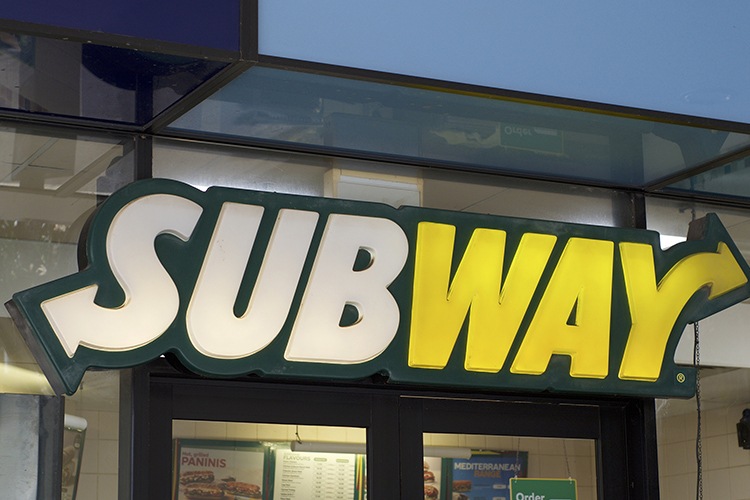The Subway logo is bright green and yellow; those two colors emphasize the freshness and positive feelings the brand has tried to emphasize from its early days. Subway has a reputation as the “healthy” alternative in the fast-food universe, and its bright, dynamic logo is an important part of that image.

Start of Subway
In 1965, Fred DeLuca was a 17-year-old in Bridgeport, Connecticut. He dreamed of going to college and medical school, but his family didn’t have the money.
Looking for a way to fund his school tuition, he talked to family friend Peter Buck, who suggested he open a sandwich store. Buck loaned him $1000, which would be about $8000 in today’s dollars. That same year, he opened Pete’s Super Submarines in Bridgeport.
Fresh Ideas
DeLuca focused on making sandwiches that had fresh ingredients and bread from local bakeries. Advertisements proclaimed that each sandwich was a full meal packed with vegetables, meat and tasty condiments.
Submarine sandwiches, also known as hoagies or subs, were extremely popular in New York, New Jersey and other nearby states. DeLuca wanted to serve sandwiches that used the same subway style but offered more options than the standard Italian cold cuts.
Doctor’s Associates
In 1966, DeLuca and Buck formed a partnership they named Doctor’s Associates. The name referred to DeLuca’s plan to make enough money to pay for his degree.
The restaurant was a huge success. The partners sold more than 300 sandwiches the first day. Within two years, DeLuca and Buck had opened four new locations. The chain’s most popular sandwich was its BMT, which it marketed as the “Biggest, Meatiest, Tastiest.” It also sold a smaller version of the submarine called the Snak, which eventually became the 6-inch sandwich we know today.
First Logo
In the early 1970s, the partners hired Dick Pilchen as their first employee. Hired to run the company’s marketing, Pilchen suggested changing the name. They chose the name Subway, and Pilchen designed the first Subway logo.
He later said he envisioned a subway that goes uptown and downtown, and he wanted that in the logo. He created the well-known arrows in the logo that point in opposite directions to signify the movement of a subway line.
The idea of movement also went well with Subway’s image as a health-conscious choice aimed at active individuals.
The partners continued opening more stores and by 1974, there were 16 Subway restaurants in Connecticut.
The logo in the 1970s became bolder. It now featured a long, green oval that looked like a subway. The letters SUB were in white, and the letters WAY were in bright yellow. The choice of green promoted Subway’s use of fresh fruits and vegetables.
Related: How to trademark a logo
Franchises
From day one, the partners’ motto was “Think Big.” They had an ambitious goal of opening 32 restaurants by the next year, but they realized they couldn’t reach that number unless they agreed to franchise their chain. Their first franchisee was their friend Brian Dixon.
By 1982, there were 300 Subway restaurants across the country. The company began looking for overseas locations and opened its first international location in Dubai.
First Logo Changes
The logo went through a change. It still had the two-color white and yellow scheme, but the green subway was gone, and the letters were now slanted.
In 1983, Subway introduced freshly baked bread at every restaurant. This caused the restaurants to soar in popularity. The low cost to franchise a Subway helped fuel more growth. By 2004, Subway had 13,247 locations, which was more than any other fast-food chain, including McDonald’s.
Marketing Campaigns
Subway has had some memorable advertising campaigns over the years. These campaigns focused on likable spokespersons who used Subway as a convenient way to eat healthy food on the run.
Its famous tagline, “Eat Fresh,” is one of the most memorable slogans in advertising history. It uses two words to sum up what sets the chain apart from its competitors.
Pilchen came up with the idea of product placement, and Subway sandwiches appeared in movies like Happy Gilmore, Lethal Weapon and Terminator 2. He also wrote one of Subway’s early radio jingles, which said, “When you’re hungry, make tracks for Subway.”
Subway Diet
Its most famous spokesperson was probably Jared Fogle. Fogle was an obese man who said he used Subway’s lower-calorie menu options to lose weight. In a letter to the company, he said he ate at Subway twice a day and took daily walks. On this plan, he lost more than 200 pounds.
Subway hired Fogle, who became the face of the company for more than 10 years. The “Subway Diet” became a media sensation. Fogle appeared in dozens of ads showing how much weight he had lost. A scandal later ended Fogle’s career with Subway.
Associations with Athletes
The company has also emphasized its association with health and fitness by hiring athletes as spokespersons In 2009, the company hired Olympic swimmer Michael Phelps, who was shown enjoying Subway fare as part of his training routine.
Pole vaulter Holly Bleasdale has appeared in ads with the tagline, “Train hard. Eat fresh.”
In recent years, the company’s commercials have featured Bill Belichick, coach of the New England Patriots, and Seattle Seahawks quarterback Russell Wilson.
Rebranding and Logo Change
In 2016, the logo went through another change. This was during a period when Subway needed rebranding and new marketing. The company had been closing stores steadily since 2014. It had gone through a public relations disaster when its most famous spokesperson, Jared Fogle, was convicted on child pornography charges.
The rebranding made only subtle changes to the well-known Subway logo. It uses brighter and bolder colors. The arrows are more pronounced to emphasize the idea that you get many choices at Subway.
Make It Your Way
Subway launched a new marketing campaign in 2018. The “Make It What You Want” campaign focused on Subway as a place where you could completely customize your sandwich.
Did the rebranding work? As of 2021, Subway has 22,226 locations in the U.S. Business has slowed down as it has for many restaurants. Only time will tell if passengers continue to get on the bright green and yellow subway.

